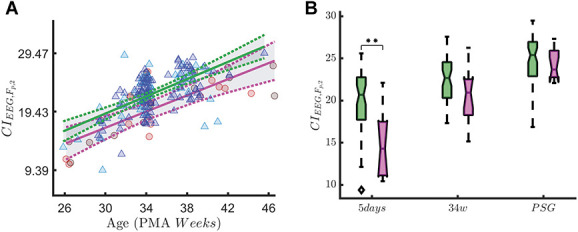Figure 4.

Complexity index (CI) in nonquiet sleep. The figure shows the association with CI and early skin-breaking procedure (SBPs). Data are reported for the entire data set during nQS. The left panel shows how the CI maturational trend differs in case of high SBPs (magenta curve, SBPs ≥50) compared to low SBPs (green curve, SBP <50). The blue/green triangles represent the patient with low SBPs (N = 73) and red/orange circles the high SBPs (N = 19). The right panel shows the boxplot trend as output of the two-way ANOVA: the division between HIGH SBPs and LOW SBPs is reported for each recording time. The CI increases over time (main effect of measuring point: F(2,178) = 42.17, P ≤ 0.01), but statistically significant interaction effect between measuring point and SBPs group is found (F(2,178) = 6.62, P ≤ 0.01). The simple main-effect analysis shows a lower complexity in HIGH SBPs group at the 5-day recording (P ≤ 0.01, indicated as ** in the figure), but there is no significant difference for the 34-week (P = 0.59) or PSG (P = 1) recording time. ANOVA, analysis of variance.
